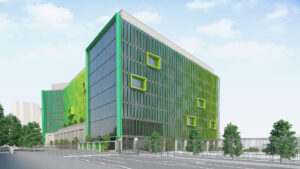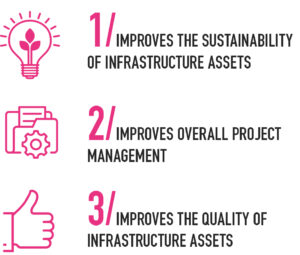Creating inclusive infrastructure
Inclusive infrastructure is about making people’s everyday lives easier. To achieve this, the social impact of infrastructure needs to be considered at every stage from the initial planning and design through to the day-to-day operation. AECOM’s Derval Cummins, European Advisory Leader discusses how the focus has shifted to value a holistic approach in thinking about how infrastructure can best meet the needs of all its customers.
At its best, infrastructure can change the behaviour and habits of the people it serves; driving a wide social impact. Infrastructure, and the services it enables, can connect and empower otherwise isolated individuals, improve a country’s overall efficiency and inspire a future generation of innovators.
However, different customers will have different needs and experiences. Creating a positive social impact doesn’t happen by chance; it means incorporating stakeholder concerns into the planning stage and then educating people in the delivery to make sure everyone benefits.
Infrastructure for all – why it matters
The United Nation’s (UN) Sustainable Development Goals (SDGs) are the blueprint to achieve a more sustainable and inclusive future for all. Its ‘2030 Agenda for Sustainable Development’ is underpinned by three pillars of sustainability: social, economic and environmental, and also includes a commitment to “Leave No One Behind”. Project Ireland 2040 closely aligns its ten National Strategic Outcomes (NSO) with the 17 UN SDGs, notably NSO 10: Access to Quality Childcare, Education and Health Services. Integrating social inclusion into the heart of infrastructure design is key to meeting this commitment, which may also mean retrofitting existing infrastructure including transport systems, public spaces and housing to become more inclusive.
All project stakeholders need to ensure processes and expertise are in place so all groups in society are assisted by the infrastructure that is put in place. With expert spokespeople for the most vulnerable groups in society at the senior decision maker level, public and private stakeholders can use new infrastructure to help meet these objectives.
Decision-making can be assisted by placing a greater emphasis on valuing the social impacts of transport and other infrastructure within the project appraisal process. This is about understanding the benefits people get from being able to access all the opportunities and services that society and the economy have to offer.
The population needs across the island of Ireland are changing. In RoI ESRI projections indicate the number of people aged over 65 will more than double to 1.3 million people by 2040, making up approximately 23% of the population. The 2016 Census showed approximately 650,00 people with a disability in Ireland, comprising around 13% of the population.
Similarly, the Northern Ireland Statistics and Research Agency (NISRA) estimates that 1 in 5 live with a disability and the population has seen a 30% increase in the 85-and-over age group in the last decade. These shifting demographics and societal needs place additional strains on public finances for infrastructure such as transport, housing and healthcare. Effective infrastructure planning is a proactive move to help reduce reactive spending in the future.
Within our survey of construction professionals, social impact matters – three quarters of respondents say it is either extremely or very important to their business.
Just like our respondents, we understand that to deliver what both the client expects and the customer needs, social implications must be incorporated into project design to consider the impacts on the wider community. We carry out stakeholder engagement throughout our design processes to ensure we understand who we are designing infrastructure for.
For example, when designing hospitals, there is a careful balance to be struck between the practical engineering and clinical design considerations and the need to design buildings which make the experience as comfortable as possible for patients. As the lead multi-disciplinary designer of multiple projects at the Royal Victoria Hospital site in Belfast, it was vital to undertake a series of rigorous meetings with clinical staff and differing patient groups, including children and young people. Through engaging with different stakeholder groups, we can better understand accommodation needs, gain unique insights into their experiences and preferences for a hospital environment to aid both patient wellbeing and staffing needs.
Project Ireland 2040’s National Development Plan 2018 – 2027 commits significant investment in public transport to achieve NSO 4: Sustainable Mobility though the BusConnects and DART Expansion programmes, and Metrolink. These will be delivered to the latest standards of accessibility, connecting citizens to more places throughout the Dublin area. The BusConnects programme will transform the entire bus network in Dublin, it is this extensive coverage that will provide a very significant social impact – making a difference to many people.
Transport is not all about infrastructure, it merely enables travel to happen whether by bus, train, tram, bicycle or foot. The quality, affordability, safety, security and customer care is all important. This also applies to the operation of roads particularly in a digital future with increasing levels of vehicle automation and connection to the infrastructure.
Case study: Royal Victoria Hospital, Children’s Hospital, Belfast

This new £125m facility at the Royal Victoria Hospital will bring together paediatric facilities from multiple sites to become Northern Ireland’s regional children’s hospital.
The ten-storey building will accommodate 155 inpatients, most of whom will be in single rooms with private ensuites, with ward facilities providing play and parent areas. Ten theatres and an emergency department capable of catering for up to 45,000 patients per annum, 10,000 more than is currently capable.
As one of the tallest hospital buildings in Northern Ireland, the patient bedrooms are strategically placed on the upper floors to capture the sweeping views of the city. This ensures a strong visual focus for visitors and patients internally. Additionally, as part of the health and wellbeing criteria our design maximises the capturing of daylight and creating a connection with the outdoor.
Looking at the building from a child’s perspective and putting the child’s needs at the centre of the project, our team incorporated key features to help ease a child’s time in hospital. Not only will the hospital provide world-class medical facilities to treat more children, it also creates a non-clinical, engaging and healing environment providing huge benefits for communities across the Province.
Empowering the customer
 Infrastructure is meant to last. However, nothing stays the same and while infrastructure is designed for one era, it must continue to function into another. For infrastructure to be futureproofed, its users need to feel engaged and enhanced by it through their daily use. Our survey respondents state the top three benefits of incorporating social impact into their business model are:
Infrastructure is meant to last. However, nothing stays the same and while infrastructure is designed for one era, it must continue to function into another. For infrastructure to be futureproofed, its users need to feel engaged and enhanced by it through their daily use. Our survey respondents state the top three benefits of incorporating social impact into their business model are:
By choosing three diverse benefits from across the supply chain, it shows how integral social impact is in the construction sector’s mindset, seeing the benefits to not only project management and delivery, but also in the output itself in better quality and more sustainable results in the long run.
Paul Harper, Director of Asset Delivery at Northern Ireland Water agrees that empowering and educating stakeholders improves infrastructure outcomes for everyone; NI Water’s 2021-2046 strategy aims to take a more holistic, interconnected approach that considers social impact across all processes. “Looking at it from a source to tap and then a sink to sea we can begin to better appreciate how things connect together. If you touch one part of the system, it trickles right around.”
When infrastructure is so interconnected, small iterative improvements can be combined together to make large scale changes in improving the functionality of the infrastructure for everyone. This means understanding the full cycle of how infrastructure is being used and by who. By taking a step back and looking at the whole journey, it means infrastructure providers can see where there is potential for different stakeholder groups to change their behaviour to either improve the performance or reduce the strain placed on the infrastructure.
For example, NI Water is currently working with farming stakeholders to see if changes can be made in how farming operations impact the water sources upstream. NI Water has identified if farmers were to change their practice to reduce the pesticides that go into the water stream close to the source, it will reduce pressures on the systems downstream to filter and treat the water.
Building up these stakeholder relationships is key to ensuring infrastructure becomes better understood and valued as an asset that needs to be both protected and preserved by all. It widens the public awareness of how integral infrastructure is and how we use it, despite most often taking it for granted.
Enfranchising the citizen
New infrastructure projects will always leave a footprint on the communities they are built in. For those communities, feeling included and invested in the infrastructure surrounding them can be critical for it being viewed as a success and embraced as a local asset.
Better engagement between infrastructure authorities and service providers and the citizen or customer is needed. This will serve two purposes:
Firstly, if authorities and service providers understand more about how and why people use infrastructure, they can design services accordingly. Given that infrastructure is often a scarce resource, they can work with customers to see where they could change their behaviour to place less demand on the system.
As Paul describes, a priority for NI Water is reducing the amount of water processed through the system. “As it is a circular system, the aim is to extract less water overall. That comes down to education among the whole population. The less we have to extract, the less we have to pump, the less we have to treat and so forth.”
Secondly, by integrating lessons about infrastructure into the school curriculum, the trickle-down effect of this should help inspire engineers and designers of the future. By building these relationships between the infrastructure sector and education providers, the social impact is generated through a co-sharing of knowledge and experience can help to position infrastructure at the heart of communities.
The social impact of infrastructure – from cradle to grave
AECOM recognises that considering the social impact of projects is only going to grow in importance across the island of Ireland. Engaging with stakeholders is vital in this process to get a full understanding of what their needs from the infrastructure are, and to think of innovative ways that the design can incorporate these.
Case study: Rainwater Garden, Clandeboye Primary School

At Clandeboye Primary School, AECOM has built a sustainable drainage solution for rainwater to prevent the risk of flooding to the school. The project was delivered in partnership with NI Water and the Department for Infrastructure, Education Authority.
When designing the project, a specific focus was to design something that would be beneficial and educational to the school environment. One part of this was thinking how to use the playground space in a way that would work alongside the children’s play. The design included a storm tank, with flows being released into a shallow stream to create a ‘duck race’ for the children. Whilst this was challenging for AECOM to incorporate into the design, it was one of the project’s biggest successes in impressing the teachers and board of governors.
The project has given the school the opportunity to extend their outdoor learning and increase the students understanding of the wider ecosystem that their school is based in. The main storage area is in two ponds at the bottom of the school campus where children are able to have lessons on nature and pond dipping as well as the area having a directly functional role too for preventing flooding.
Samuel Donaldson, Principal Water Engineer leading the design of this scheme states, “having the opportunity to take a challenging flood risk reduction scheme and turn it into an outdoor classroom not only improves the environment but leaves a lasting legacy in educating future generations on the workings of the world around them”.






